Other
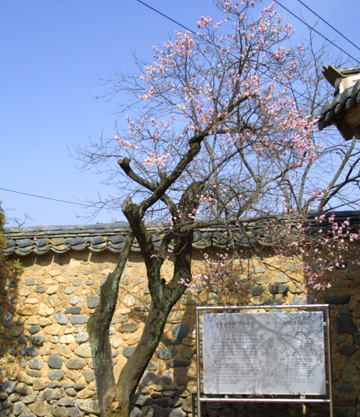
The old house of the Choe clan in Namsa-ri, Danseong-myeon is the largest residence in the village. In these homes built by the elite scholarly class of the Joseon era, one can observe how the spaces inhabited by men and women were divided under the influence of Confucian values, with outstanding layout techniques that emphasized the autonomy of the feminine spaces.
The inner wing, ikrangchae, sarangchae, and other rooms are arranged in a rectangular formation with the inner wing as the center. To the left and right of the sarangchae there are two doorways that lead to the inner courtyard. An interesting feature of the architecture is that if you open the door on the right, the space is quite open with a full view of the inner wing but if you enter through the west door, the fence (arranged in a V shape) obscures the ikrangchae and inner wing from the direct gaze.
The old home of the Choe family has a five-girder design with Paljak roofs; the inner wing is 6 rooms in the front and 3 rooms to the side, with front/back toe. The building is tall, with sturdy materials. The sculpted decorations on the double doors are delicate and beautiful, embodying the dignity of a beautiful home of the ruling class. The sarangchae is also a five-girder design with Paljak roofs with 5 rooms in the front and 3 rooms on the side and front/back toe. As in the case of the inner wing, this has a double-space layout plan.
Near the old home of the Choe clan, there is a large persimmon tree standing at the bend of the broad road in front of the village as you walk along the stone fence. Once you enter the gateway right in front of this tree, you will see a sign informing you that this has been designated Gyeongsangnam-do Cultural Heritage Material 117 and next to this there is an old but well-cultivated white blossom Ume tree, growing 7.0m tall with a width of 5.5m and a root collar diameter of 27.6m.
According to the entry on the “Sangryangmun Gate” in the cultural heritage management registry, the framing of the house took place in July of 1920, which means that the building was constructed around 8 decades ago, but the apricot tree planted here appears to be one which had been growing at least 20 years before being transplanted here. In late March, the tree gives forth blooms that fill the branches with their brilliant white hue.
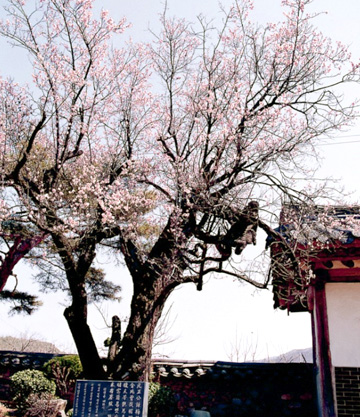
Namsa Village, located in Danseong-myeon, Sancheong-gun, Gyeongsangnam-do was founded around five centuries ago. It includes several old homes designed in the traditional style of the Joseon period, and due to the antiquity of the village, one can see several old spindle trees. The village is also famed for being the home of many ancient apricot trees. One of the old houses in the village is the "Bunyang House," which has been the residence of the Ha clan of Jinyang for 32 generations.
This was the residence of Ha Jip (1303~1380), nicknamed "Wonjeonggong" (which means bringing joy to the people by practicing good works and inspiring obedience by practicing justice). Ha Jip served in the office of "jinsa" in 1324 at the age of 21 and was appointed to the third governmental ranking level in the gapgwa division of the mungwa service. He served in the offices of Gyeongju Buyun and Munhwa Chanseongsa and finally was appointed to the position of Suchungjwari gongsinjungdae gwangboguksungrokdae bujincheonbuwon.
This house was destroyed during the Donghak Peasant Revolution and was newly built by Ha Cheol, the 31th generation descendant of Ha Jip. The house is adorned with a frame that says "Bunyanggoga," expressing the heritage of an old and renowned family. In the front of the sarangbang, where the family keeps a frame with the phrase “Wonjeongguryeo” in the personal handwriting of Daewongun, there stands an apricot tree that has withstood 610 years, alongside a handsome pine tree. This apricot tree was planted by Wonjeonggong Ha Jip during the Goryeo Dynasty. It exhibits the dignity befitting an ancient apricot tree, and still gives forth light pink blooms in late March.
In front of the Wonjeongmae apricot tree, there is a petite 'Maehwasibi' in which a poem praising the apricot tree is engraved, expressing the deep sentiments of love harbored by Wonjeongong regarding the apricot tree and all that it symbolized. Meanwhile, the backyard of the house has a 600-year old persimmon tree which is said to have been personally planted by Ha Yeon, who served in the highest office of Yeonguijeong during the reign of King Sejong of Joseon.
According to Daedongbo (Volume 1) of the Jinyang Ha Clan, after 1377 Wonjeonggong built a house in Songak and named the building "Songheon", and recorded that he "early on planted an apricot tree." Considering that the persimmon tree planted by his grandson is now 580 years old, the present apricot tree is estimated to be over 610 years old.
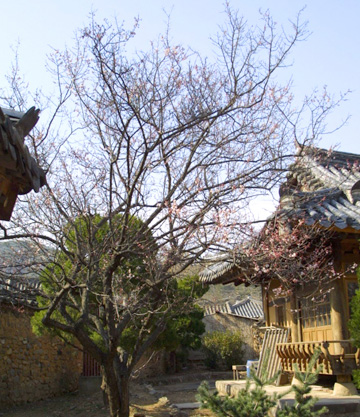
The neighborhood of Namsa-ri in Sancheong has been the site of many historical old homes, and although some of these have been destroyed by lack of care and neglect over the years, there are a few that have been well preserved: one of these is the old house of the Jeong clan.
The building of the Jeong home shares the same layout as the old home of the Choe clan. One feature unique to the Jeong house, however, is the presence of a detached building called "Sayangjeongsa Shrine." Each detail of the comb-like "bitsal" pattern of the window grille has a time-honored beauty that bespeaks the excellence of our traditional architectural culture. Behind the main building, there is another small detached structure called "Seonmyeongdang," and near the fence on the left-hand side, an old apricot tree stands.
This 100-year old tree is a red plum blossom, with a height of 6.0m and a width spanning 5.8m east to west, and a root collar diameter of 24.8m. According to the cultural heritage registry of Uri-gun, the completion of the framework of this house was dated as 1910, which is around 9 decades ago, but the apricot tree we see planted here is deduced to have been quite well grown at the time it was transplanted here.
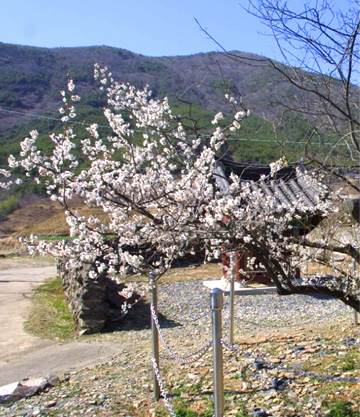
In Un-ri, Danseong-myeon, Sancheong-gun, Gyeongsangnam-do the ridge of Jirisan Mountain slopes down vigorously and stops at Ongnyeobong Peak. The Dansoksa Temple Site is positioned below this peak facing south. To the east and west, there stand the three-story stone pagodas, while corner stones are scattered haphazardly amid these, there stands an old apricot tree named Jeongdangmae.
According to the book 《Yanghwasorok (an encyclopedia on horticulture)》 written by Injae Gang Hui-an (1419~1464), it is written that his ancestor Tongjeonggong planted an apricot tree with his own hands in his youth while staying at Jirisan Mountain‘s Dansoksa Temple to study and that he recited a poem afterwards. The ancestor referred to by Injae here is Tongjeong Gang Hoe-baek (1357~1402) who served in the government in the late Goryeo Dynasty; he passed the civil service exam in the 2nd year of King Uwang‘s reign (1376) and was gradually promoted to higher appointments, finally attaining the position of Jeongdangmunhak (chancellery scholar, a governmental position in Jungseoseong (Grand Secretariat) and in Munhaseong (Chancellery), with a ranking of jong-2-pum) and Daesaheon. After Jeong Mong-ju was killed in the 4th year of King Gongyang (1392) Tongjeong was sent into exile in Jinyang but was later appointed to the position of Dongbuk-myeon Dosunmunsa (district governor), in the 7th year of King Taejo after the founding of the Joseon Dynasty (1398).
He was a native of Sancheong, Gyeongsangnam-do and became the grandfather of Injae Gang Hui-an. The poem that he read after planting Jeongdangmae is as follows.
Another poem recorded in the Tongjeongjip is one which he recited upon returning to visit Jeongdangmae, the apricot tree he had planted, at the age of 46 as he anticipated the end of his life. This poem greatly moves the reader with its deep poignancy and sentiment.
The monks of Dansoksa Temple reflected on his talent and virtue and admired his clean dignity and noble character; they said that the sight of the apricot tree reminded them of him. Each year, they strengthened the roots with soil and cultivated the health of the tree according to season.
The branches bend gently, and blue moss covers the tree trunk; its appearance is the very image of the old apricot described in Maebo; it is thus the true ancient visage representative of Yeongnam. Anyone who visited this region of Yeongnam on governmental business would make sure to visit Dansoksa Temple to admire the apricot tree and compose a poem corresponding to the spirit of our ancestor‘s poem, leaving the poem hanging above the door.
Thus the monks of Dansoksa Temple looked after the apricot tree with attentive care and the descendants of Tongjeonggong and the officials who came down from the capital to Yeongnam would frequently come to pay homage to Jeongdangmae. Since it is recorded that Tongjeonggong planted this apricot tree at an age when he was a boy reading in the Dansoksa Temple, if we assumed that he was under the age of 20 when he studied at this temple, before taking a governmental position, then we can estimate that the tree was transplanted before 1376 and that its age is now over 630.
At present, Jeongdangmae has a height of 8m and a circumference of 1.5m. 4 branches have grown out from the root collar and have grown upward or sideward. The color of its uni-florous blossoms is white. The tree never fails to bloom around March 20th, wafting a pure scent into the air.
The descendants built a structure housing a monument to honor Jeongdangmae. Maegak was built in 1915 along with the erection of the "maebi" momument. There is a sign that says 'Jeongdangmaegak' and inside the building we can find the "Jeongdangmaegakgi" which is a record of the reason for this memorial building, as well as the poem "Maehwawonun" by Tongjeonggong himself as well as various poems composed by descendants.
As of November 10, 1982, Jeongdangmae became the tree that officially represents the province of Gyeongsangnam-do and has been designated as a protected tree (registry number 12~41).
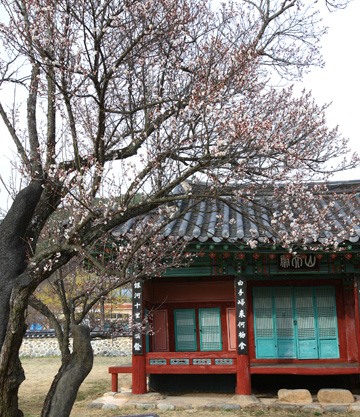
In the courtyard of Sancheonjae, located below Jirisan Mountain‘s Cheonwangbong Peak in the district of Sicheon-myeon, Sancheong-gun, there grows an apricot tree that was personally planted by Nammyeong Jo Sik (1501~1572) at the age of 61, in the 16th year of King Myeongjong (1561).
Sancheonjae is the place where Nammyeong pursued and perfected his studies; it was built in the 16h year of King Myeongjong (1561) and was renovated in the 18th year of King Sunjo (1818). Its size is 2 rooms in the front and 2 rooms on the side.
Nammyeong was a leading mind of the Honam School of scholarship, often paired as an equal alongside the renowned scholar Toegye Yi Hwang of Yeongnam. Though he never served in a government position, he was respected as a great man and was posthumously honored with the appointments as Saganwon (Office of Censor General) and Daesagan (Censor-General) and even Yeonguijeong (chief state councilor).
Nammyeong was born in 1501 (7th year of King Yeonsan) in Gyeongsang-do Samgahyeon and relocated to Seoul following his father who sought a government career. Later, he also lived in areas around Uiryeong, Gimhae, and Samga. The year he turned 61, Nammyeong finally moved to Deoksan in Sangcheong, built a study and named the space "Sancheonjae."
The phrase "sancheon," the name given to his study, is a reference to Daechukgwae in 《Juyeok》 and it points ideal of "disciplining oneself with sincere diligence and strong rectitude, thus accumulating good deeds that will shed light outwards, and renewing the good each day." The phrase thus clarifies the path to be taken by the scholar; the scholar ought to maintain strong integrity and sincere diligence, avoid worldly affairs, and insulate himself to train one‘s heart and mind to build discipline."
After building Sancheonjae, Nammyeong planted an apricot tree in the yard with his own hands. He grew to deeply love the apricot tree which gave forth gorgeous blossoms each year. The following poem allows us to imagine the deep affection that he had for this apricot tree.
The Nammyeongmae, which stands in the yard of Sancheonjae, is said to have been planted at the time Sancheonjae was built, which means that it is now around 440 years old. The trunk splits at the bottom into three large branches, which twist as they reach upward. The branches in the top part have withered away and died, but new branches are delicately growing, indicating that the tree is in relatively good health. Each year in late March, the tree is decked with light pink blooms of semi-double flowers and the scent is extremely pure. Nammyeong refused to compromise with the unjust and avoided a governmental career all his life, practicing a true life of upright solitude: his clean and honorable spirit seems to remain infused into the scent of his apricot tree.
Near the hillside in the direction of the river that runs near the end of Sancheonjae‘s garden, there is another small apricot tree that appears to have been planted after the Nammyeongmae. Also, in the outer yard of Sancheonjae there are several broad leaved evergreens known as thorn trees that are beautiful in form and sturdily grown, adding to the atmospheric poignancy of the scene.
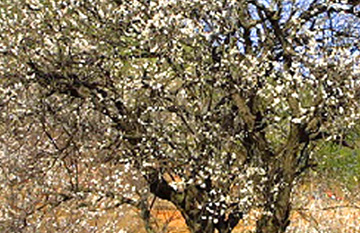
Perhaps due to the influence of the famed Jeongdangmae apricot tree, in the vicinity of the village of Unri, Danseong-myeon, Sancheong-gun we find natural growths of very old apricot trees in the fields and at the foot of hillocks.
Around 300m left of the site, there are two apricot trees: the first, which grows in a furrowed field, is a 350-year old white-blossomed ume tree with a root collar diameter of 63㎝, while the second tree is a healthily grown white-blossomed ume tree with a height of 5.5m and width of 5.0m, estimated to be around 150 years old. Also, at the foot of the gently sloping Duryusan Mountain west of Unri Village, we find a wild apricot tree growing in the midst of the brush, exhibiting the sturdiness of the species. There is a 150 year-old white blossomed tree with a height of 3m and a root collar diameter of 51㎝ and a 100-year old white blossomed tree growing to a height of 6.0m with many branches.